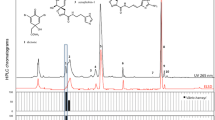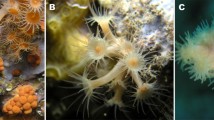Abstract
Intraspecific variation in the composition of three cytotoxic secondary metabolites from the New Zealand marine sponge Mycale hentscheli collected at two sites in central New Zealand was quantified by 1H NMR techniques. A total of 275 sponges were analyzed bimonthly over 15 mo to compare intersite (∼100 km) and intrasite (∼100 m) spatial and temporal variations in the metabolites. Biological and physical characteristics of sponge size, morphology, depth, and temperature were recorded at each site. Metabolite concentrations were found to vary in space and time. Metabolite composition was site-specific; mycalamide A, pateamine, and peloruside A were present at Pelorus Sound, whereas pateamine was absent from sponges at Kapiti Island. Pateamine and peloruside A concentrations in sponges at Pelorus Sound varied seasonally; no such patterns were observed at Kapiti Island. Relationships of compound concentration with volume and depth were complex. High levels of peloruside A in Pelorus Sound sponges from between 8 and 10 m depth coincided with a density boundary layer and chlorophyll a maximum.





Similar content being viewed by others
References
M. A. Becerro X. Turon M. J. Uriz (1995) ArticleTitleNatural variation of toxicity in encrusting sponge Crambe crambe (Schmidt) in relation to size and environment J. Chem. Ecol. 21 1931–1946
P. R. Bergquist P. J. Fromont (1988) ArticleTitleThe marine fauna of New Zealand: Porifera, Demospongiae, Part 4 (Poecilosclerida) Mem. N.Z. Oceanogr. Inst. 96 138
Chanas, B. and Pawlik, J. R. 1997. Variability in the chemical defense of the Caribbean reef sponge Xestospongia muta. Proceedings of the 8th Coral Reef Symposium 2:1363–1368.
Duckworth, A. R. 2000. Aquaculture of sponges for production of bioactive metabolites. Ph.D. dissertation. University of Canterbury, Christchurch.
A. R. Duckworth C. N. Battershill (2003) ArticleTitleSponge aquaculture for the production of biologically active metabolites: The influence of farming protocols and environment Aquaculture 221 311–329
E. J. Dumdei J. W. Blunt M. H. G. Munro C. N. Battershill M. J. Page (1998) The whys and whats of sponge chemistry: Why chemists extract sponges and what problems does this cause? Y. Watanabe N. Fusetani (Eds) Sponge Sciences. Multidiscipinary Perspectives Springer Tokyo 353–364
P. E. Fell K. B. Lewandrowski (1981) ArticleTitlePopulation dynamics of the estuarine sponge Halichondria sp., within a New England eelgrass community J. Exp. Mar. Biol. Ecol. 55 49–63
M. M. Gibbs (2001) ArticleTitleSedimentation, suspension and resuspension in Tasman Bay and Beatrix Bay, New Zealand, two contrasting coastal environments which thermally stratify in summer N.Z. J. Mar. Freshw. Res. 35 951–970
M. M. Gibbs A. Ross M. Downes (2002) ArticleTitleNutrient cycling and fluxes in Beatrix Bay, Pelorus Sound, New Zealand N.Z. J. Mar. Freshw. Res. 36 675–697
C. D. Harvell W. Fenical V. Roussis J. L. Ruesink C. C. Griggs C. H. Greene (1993) ArticleTitleLocal and geographic variation in the defensive chemistry of a West Indian gorgonian coral (Briareum asbestinum) Mar. Ecol. Prog. Ser. 93 165–173
M. E. Hay (1996) ArticleTitleMarine chemical ecology: What’s known and what’s next J. Exp. Mar. Biol. Ecol. 200 103–134
Hintze J. L. 1997. NCSS 97: User’s Guide — I. Number Cruncher Statistical Systems, Kaysville, Utah.
K. A. Hood L. M. West P. T. Northcote M. V. Berridge J. H. Miller (2001) ArticleTitleInduction of apoptosis by the marine sponge (Mycale) metabolites mycalamide A and pateamine Apoptosis 6 155–166
M. Kelly-Borges J. Vacelet (1995) ArticleTitleA revision of Diacarnus Burton and Negombata de Laubenfels (Demospongiae: Latrunculiidae) with description of new species from the West Central Pacific and the Red Sea Mem. Queensl. Mus. 38 477–503
M. Maida A. R. Carroll J. C. Coll (1993) ArticleTitleVariability of terpene content in the soft coral Sinularia flexibilis (Coelenterata: Octocorallia), and its ecological implications J. Chem. Ecol. 19 2285–2296
E. Meroz M. Ilan (1995) ArticleTitleLife history characteristics of a coral reef sponge Mar. Biol. 124 443–451
M. H. G. Munro J. W. Blunt E. J. Dumdei S. H. Hickford R. E. Lill L. Shangxiao C. N. Battershill A. R. Duckworth (1999) ArticleTitleThe discovery and development of marine compounds with pharmaceutical potential J. Biotechnol. 70 15–25
P. T. Northcote J. W. Blunt M. H. G. Munro (1991) ArticleTitlePateamine: A potent cytotoxin from the New Zealand marine sponge Mycale sp Tetrahedron Lett. 32 6411–6414
N. B. Perry J. W. Blunt M. H. G. Munro L. K. Pannell (1988) ArticleTitleMycalamide A, an antiviral compound from a New Zealand sponge of genus Mycale J. Am. Chem. Soc. 110 4850–4851
M. P. Puglisi V. J. Paul M. Slattery (2000) ArticleTitleBiogeographic comparisons of chemical and structural defences of the Pacific gorgonians Annella mollis and A. reticulata Mar. Ecol. Prog. Ser. 207 263–272
D. Romo R. M. Rzasa H. A. Shea K. Park J. M. Langehan L. Sun A. Akheizer J. O. Liu (1998) ArticleTitleTotal synthesis and immunosuppressive activity of (−)-pateamine A and related compounds: Implementation of a β-lactum-based macrocyclization J. Am. Chem. Soc. 120 12237–12254
V. Roussis C. Vagias C. Tsitsimpikou N. Diamantopoulou (2000) ArticleTitleChemical variability of the volatile metabolites from the Caribbean corals of the genus Gorgonia Z. Naturforsch. 55 431–441
SAS/STAT. 1990. SAS/STAT Users Guide. SAS Institute Inc., Cary, NC
J. E. Thompson K. D. Barrow D. J. Faulkner (1983) ArticleTitleLocalization of two brominated metabolites, aerothionin and homomaerothionin, in spherulous cells of the marine sponge Aplysina fistularis (= Verongida thiona) Acta Zool. 64 199–210
J. E. Thompson P. T. Murphy P. R. Bergquist E. A. Evans (1987) ArticleTitleEnvironmentally induced variation in diterene composition of the marine sponge Rhopaloides odorabile Biochem. Syst. Ecol. 15 595–606
X. Turon M. A. Becerro M. J. Uriz (1996) ArticleTitleSeasonal patterns of toxicity in benthic invertebrates: The encrusting sponge Crambe crambe (Poecilosclerida) Oikos 75 33–40
L. M. West P. T. Northcote K. A. Hood J. H. Miller M. J. Page (2000a) ArticleTitleMycalamide D, a new cytotoxic amide from the New Zealand marine sponge Mycale sp J. Nat. Prod. 63 707–710
L. M. West P. T. Northcote C. N. Battershill (2000b) ArticleTitlePeloruside A: A potent cytotoxic macrolide isolated from the New Zealand marine sponge Mycale sp J. Org. Chem. 65 445–449
Acknowledgments
We thank Pete Notman and Rob Keysers for field support under often trying conditions. Bruce Hartill, Mathew Smith, and Crispin Middleton and Michelle Wilkinson of NIWA Auckland contributed significantly to the taxonomic and morphometric analyses in this study. Many thanks to Drs. Vicky Webb and Alison MacDiarmid, NIWA Wellington, for discussion and comments, and Drs. Don Morrissey and Russell Cole for assistance with statistical interpretation. We also thank the anonymous reviewers for helping to improve our manuscript. This research was funded by Foundation for Science Research and Technology (FRST) research contracts CO1809 and COIX0207 with NIWA.
Author information
Authors and Affiliations
Corresponding author
Rights and permissions
About this article
Cite this article
Page, M., West, L., Northcote, P. et al. Spatial and Temporal Variability of Cytotoxic Metabolites in Populations of the New Zealand Sponge Mycale hentscheli. J Chem Ecol 31, 1161–1174 (2005). https://doi.org/10.1007/s10886-005-4254-0
Received:
Revised:
Accepted:
Published:
Issue Date:
DOI: https://doi.org/10.1007/s10886-005-4254-0




